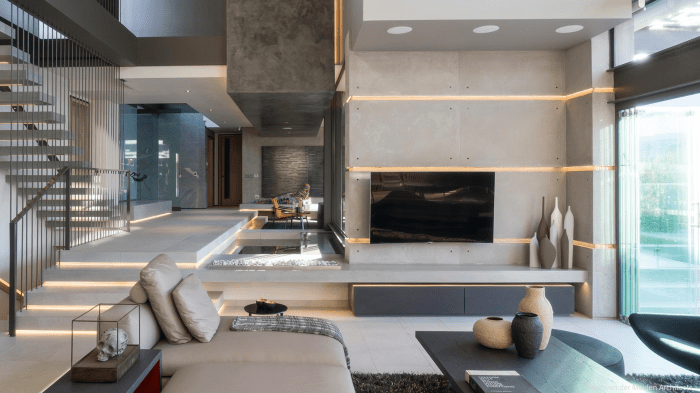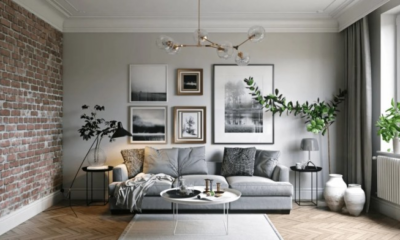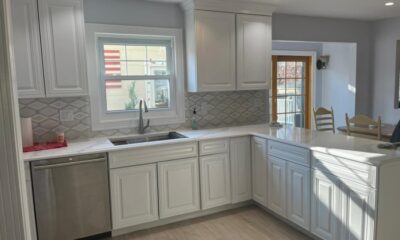Architecture
Exploring the World of Interior Architecture

Embark on a journey through the realm of interior architecture, where creativity meets functionality to shape breathtaking spaces that captivate the senses and inspire the soul.
Delve into the intricate details of this fascinating discipline as we uncover the nuances of design, history, sustainability, cultural influences, and spatial planning in interior architecture.
Introduction to Interior Architecture
Interior architecture plays a crucial role in the design of interior spaces, focusing on the structural elements and layout of a space to create functional and aesthetically pleasing environments. Unlike interior design, which primarily deals with the decoration and furnishing of spaces, interior architecture involves the design and organization of the internal structure of a building.
Significance of Interior Architecture
Interior architecture goes beyond aesthetics to consider the spatial functionality, circulation, and overall user experience within a space. By integrating elements such as lighting, acoustics, and materials, interior architects create environments that are not only visually appealing but also practical and comfortable for occupants.
Difference Between Interior Design and Interior Architecture
While interior design focuses on the selection of furniture, colors, and accessories to enhance the look of a space, interior architecture looks at the bones of a building, including walls, ceilings, and floors, to ensure that the space is not only beautiful but also structurally sound and functional.
Role of Interior Architecture in Shaping a Space
Interior architecture plays a crucial role in shaping the overall look and feel of a space. By considering factors such as spatial planning, ergonomics, and building codes, interior architects create environments that are not only visually appealing but also safe, efficient, and sustainable.
Elements of Interior Architecture
Interior architecture involves several key elements that play a crucial role in shaping the design and functionality of a space. These elements include spatial organization, materials, lighting, and furniture. Each element contributes to the overall aesthetic appeal, functionality, and mood of a space.
Spatial Organization
Spatial organization refers to how space is utilized, arranged, and divided within a design. It involves the layout of rooms, circulation patterns, and the relationship between different areas. Spatial organization is essential for creating a harmonious flow and ensuring that the space is functional and efficient.
For example, open floor plans are commonly used to create a sense of spaciousness and connectivity in modern interior designs.
Materials
Materials play a significant role in interior architecture as they determine the look, feel, and durability of a space. From natural materials like wood and stone to synthetic materials like glass and metal, each material choice has a unique impact on the design.
For instance, the use of reclaimed wood can add warmth and character to a space, while sleek metal finishes can create a modern and industrial aesthetic.
Lighting
Lighting is a crucial element in interior architecture as it can dramatically affect the mood and functionality of a space. Proper lighting design involves a combination of natural and artificial light sources to create the desired ambiance. For example, strategic placement of lighting fixtures can highlight architectural features, create visual interest, and enhance the overall design concept.
Furniture
Furniture plays a dual role in interior architecture, serving both functional and aesthetic purposes. The choice of furniture can define the style of a space and provide comfort and usability. Innovative use of furniture design, such as modular or multifunctional pieces, can maximize space efficiency and adaptability in interior layouts.
History and Evolution of Interior Architecture

Interior architecture has a rich history that dates back to ancient civilizations and has evolved significantly over the centuries. Various architectural movements and technological advancements have played a crucial role in shaping the interior design we see today.
Ancient Civilizations
Interior architecture can be traced back to ancient civilizations such as Mesopotamia, Egypt, Greece, and Rome. In these early societies, interior spaces were designed with a focus on functionality and symbolism. For example, the Greeks incorporated columns and statues in their interiors to reflect their values of beauty and harmony.
Architectural Movements
Throughout history, architectural movements like Gothic, Renaissance, Baroque, and Art Deco have influenced interior design trends. The Gothic period, known for its pointed arches and ribbed vaults, inspired intricate details in interior spaces. The Renaissance brought a revival of classical elements, such as symmetry and proportion, while the Baroque era introduced ornate decorations and dramatic lighting effects.
In the 20th century, the Art Deco movement embraced geometric shapes and luxurious materials, influencing interior architecture with its glamorous aesthetic.
Impact of Technology
Advancements in technology have revolutionized interior architecture, allowing designers to experiment with new materials, techniques, and styles. The introduction of CAD software, 3D printing, and smart home technology has enabled designers to create innovative and sustainable interior spaces
Sustainable Practices in Interior Architecture
Sustainable practices in interior architecture focus on creating designs that are environmentally friendly, energy-efficient, and socially responsible. By incorporating sustainable design principles, interior architects can help reduce the negative impact of buildings on the environment and promote a healthier living and working environment.
Use of Eco-Friendly Materials
Interior architects prioritize the use of eco-friendly materials such as recycled wood, bamboo, cork, and reclaimed metal to minimize waste and reduce carbon footprint. These materials not only contribute to sustainable design but also add unique textures and aesthetics to interior spaces.
Energy-Efficient Solutions
Incorporating energy-efficient solutions like LED lighting, solar panels, and smart thermostats helps reduce energy consumption and lower utility costs. By optimizing natural light and ventilation, interior architects can create spaces that are both comfortable and environmentally conscious.
Importance of Sustainability
Sustainability is crucial in contemporary interior architecture projects as it aligns with the growing awareness of climate change and the need for sustainable living practices. By integrating sustainable design principles, interior architects can create spaces that promote well-being, reduce environmental impact, and contribute to a more sustainable future.
Cultural Influences in Interior Architecture
Cultural influences play a significant role in shaping interior architecture, as different societies and traditions bring unique elements that contribute to the overall design. These cultural nuances help create spaces that reflect a sense of identity and belonging for the occupants.
Significance of Cultural Elements in Creating a Sense of Place
Cultural elements in interior architecture not only add aesthetic value but also provide a sense of place and connection to the history and heritage of a particular community. These elements can include traditional patterns, materials, colors, and motifs that are specific to a culture and help establish a unique atmosphere within a space.
Examples of Cultural Diversity in Interior Architectural Designs
- Incorporation of feng shui principles in Chinese interior design to create harmonious and balanced spaces.
- Use of intricate geometric patterns and vibrant colors in Moroccan interiors to reflect the country's rich artistic heritage.
- Integration of natural materials like wood and stone in Scandinavian design to evoke a sense of connection to nature and simplicity.
- Adoption of bright textiles and handcrafted elements in Mexican interiors to celebrate the country's vibrant cultural traditions.
Spatial Planning and Functionality
Spatial planning plays a crucial role in interior architecture as it involves the strategic organization of spaces to enhance functionality, efficiency, and overall user experience. By carefully considering the layout, flow, and utilization of space, interior architects can create harmonious environments that cater to the needs and activities of the occupants.Functionality is a key aspect that needs to be balanced with aesthetics in interior design.
While the visual appeal of a space is important, it should not compromise the practicality and usability of the design. A successful interior architecture project seamlessly integrates both functionality and aesthetics to create spaces that are not only beautiful but also highly functional and user-friendly.
Tips for Optimizing Space
- Utilize multifunctional furniture pieces to maximize space efficiency.
- Consider the traffic flow within a space and ensure easy movement between areas.
- Use light colors and strategic lighting to create an illusion of spaciousness in smaller areas.
- Integrate storage solutions that are both practical and visually appealing to minimize clutter.
- Customize the design to meet the specific needs and lifestyle of the occupants to optimize usability.
Final Summary
As we conclude our exploration of interior architecture, we are left with a profound appreciation for the artistry and ingenuity that define this field. From the ancient civilizations to the cutting-edge modern designs, interior architecture continues to push boundaries and redefine the way we experience built environments.
FAQ Overview
What is the difference between interior design and interior architecture?
Interior design focuses on aesthetics and functionality within a space, while interior architecture deals with the structural elements and design of interior spaces.
How do cultural influences impact interior architecture?
Cultural influences play a significant role in shaping interior architecture by reflecting traditions, values, and aesthetics unique to different societies.
Why is sustainable design important in interior architecture?
Sustainable design in interior architecture promotes eco-friendly practices, reduces environmental impact, and creates healthier living spaces for occupants.
-

 General6 months ago
General6 months agoFinding the Best Siding Contractors Near Me: A Comprehensive Guide
-

 General6 months ago
General6 months agoExploring the World of Interiors
-

 General6 months ago
General6 months agoEnhancing Your Home: Custom Home Exteriors
-

 General6 months ago
General6 months agoExploring the Roof Replacement Cost Estimate: Factors, Materials, and Labor
-

 General6 months ago
General6 months agoThe Ultimate Guide to Licensed Home Improvement Contractors
-

 General6 months ago
General6 months agoExploring the Beauty of Hardie Cobblestone
-

 General6 months ago
General6 months agoExploring the Best Replacement Window Companies for Your Home
-

 General6 months ago
General6 months agoCrafting Excellence: Professional Cabinet Painting Services





